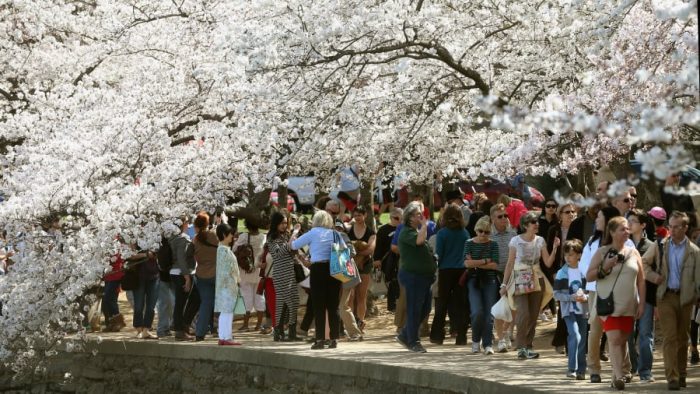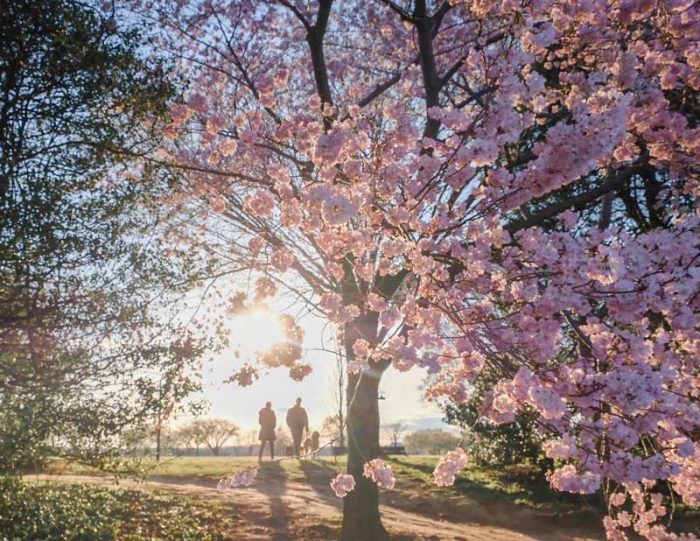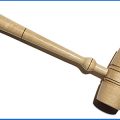Spring is here and the tourists are in full bloom
If 1.5 million people come to Washington to see the cherry blossoms, and each of them has to go to the bathroom at least once, how many miles of toilet paper do Smithsonian museums go through each day? (Show your work.)
Smithsonian custodial workers share the unheralded—but much appreciated—challenges of maintaining pristine facilities for the annual surge in visitors.

Crowds at the National Cherry Blossom Festival in Washington, DC. (Photo via CNN Travel)
When winter finally fades in Washington, D.C. and the pink blossoms on the cherry trees that circle the Tidal Basin pop open, crowds of visitors suddenly begin pouring out of cars and taxis, tour buses, the Metro and seemingly, parachuting in from above, to partake in the beauty of spring. Like a magnet, the National Mall lures groups of students on spring break, visitors from out of town and many local residents to its stunning monuments and free museums framed by the famous blossoms.
As the Smithsonian’s dedicated custodial staff are well aware, it is the season of crowds and long lines.
During the weeks when the cherry blossoms are in bloom, “we get massive crowds coming through here,” says David Felix, building services worker supervisor at the National Museum of American History. “We’re right off Constitution Avenue next to the Washington Monument, so it gets crazy—we have to double up on custodial staff.”
Long lines form at the restrooms nearest the Mall and Constitution Avenue entrances at NMAH, particularly the women’s rooms, Felix says. Every 20 minutes or so throughout the day each restroom requires servicing: refilling the one- gallon soap dispersers, toilet paper holders, seat cover containers, and “sometimes kids want to go in there and play we have to clean that up and mop up water,” Felix adds.
It is the same at Air and Space, says Patrick Grayson, NASM building services worker supervisor. “The women’s rooms get so crowded that we direct people standing in line to another bathroom on another floor.” Frequently, to shorten the long waits, the restrooms in the former McDonald’s restaurant on the museum’s East End will be open to visitors. “Every 15 to 20 minutes, one of our staff goes in to each bathroom to clean the glass, remove debris and mop up water on the floor, wipe down the toilets if needed, change sanitary boxes and refill toilet paper rolls. We’re very busy all day.”
At both Air and Space and American History custodians are also stationed outside the museum to empty the outdoor trash cans and police the area around the museum. “They pick up cups, ice cream spills, trash, boxes and whatever else the visitors may leave,” Grayson says. The outdoor trash cans at NASM fill up fast and need to be emptied every hour. “This time of year it is always busy, from the cherry blossoms until almost Labor Day.”
On Saturday mornings, custodial supervisor Joyce Clark arrives at 6:30 a.m. to get the Castle, Hirshhorn, Arts and Industries, African Art, The Sackler, Quadrangle and Freer ready for the crowds.
“The first thing I do is check to make sure all staff are here and they have their assignments and know exactly what to do. If someone is not here then I have to move someone over into their place to make sure those assignment gets done.”
When the Castle opens its doors at 8:30 a.m., the tour buses are already unloading passengers at the north door and the visitors begin filing in. Lines to the women’s bathroom start forming. “Women like to primp and they take a longer time,” Clark says. “Also, they often have little kids that they bring in with them.”
“We don’t have the bathroom capacity for all these folks but our job is to make each visitors’ experience the best it can be,” Clark adds. “The lines get long, and you are in there trying to change toilet paper, you’re trying to change soap, you are trying to change big trash cans; you’re trying to mop up this, clean out that, it can get tedious. But we always make the best of what we have.”
As they exit the buses visitors also bring along the bags, boxes, cups and wrappers from food eaten on their trip. It goes right into the trash cans around the Castle which in turn must be emptied repeatedly during the day by the Castle custodial staff, Clark says.
Food trucks that line 14th Street near the Washington Monument and along Constitution Avenue are also a source of a lot of the trash that ends up in the outdoor trashcans at American History. “They fill up real fast so they run over,” Felix says. “Our laborers go around outside the building and on weekends and busy weekdays they have to do double work. They ride a Cushman cart around the building to collect the trash.”
Even when the Smithsonian is closed in the evenings, there are lots of people on the Mall and trash still accumulates, Clark adds. “We take care of that first thing in the morning.”
At Natural History, on a busy spring day, the staff are constantly policing the museum with broom and dustpan, rags and spray bottles, cleaning smudges off the glass in the exhibits, sweeping up the floors—and, of course, cleaning the bathrooms. The museum can go through some 20 cases of toilet paper each day, with 46 jumbo rolls per case. Each jumbo roll equals almost four household rolls, so you can do the math. (And no, there’s not a square to spare.)
“It’s packed in here all summer long,” says custodial supervisor Adrianne Massey. “But we have the best crew. They keep everything going in this museum. You couldn’t ask for a better crew.”
“Summer also brings extended hours when we stay open till 7:30. In May we are opening a new Dinosaur Hall at Natural History which will bring in a lot more of people,” Building Services Worker Tenise Cruel adds.
During cherry blossom season and through the summer the team at NMAH must always stay on its toes, Felix says. “I direct the workers both inside and outside the museum. Somebody might call and say there’s a spill in this gallery on the floor, or this restroom is messed up. You’d be surprised how many people get sick inside and outside the museum on a busy day. When this happens we block off the area and clean it up with special emergency kits that contain absorbent powder. Outside, we splash it down with a bucket of water after applying the powder.”
“The custodial staff all around the Smithsonian, all of us, we try to do the best we can with what we have to work with,” Clark says. “We try to make each visitor’s experience wonderful so they come back. People save up for a long time to visit Washington, D.C., and the Smithsonian is one of the places where they don’t have to pay money to enter.”
Clark, who has worked 28 years at the Smithsonian, started off as a custodian, and became a secretary/management support assistant and then earned a certificate from George Mason University in facilities management. “This job has its moments, you can’t please everybody, but what you can do is try to do your best. This is a world class organization and we try to go above and beyond.”

A Couple walk their dog near the Tidal Basin. (Not shown: 5,000 other couples walking dogs near the tidal basin. Photo by @amandaeisner
Posted: 18 April 2019
- Categories:






